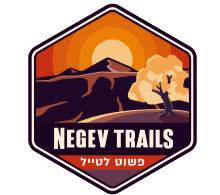We begin the hike heading south on the green-marked trail, which starts at the Albert Promenade along the edge of Ramon Crater, near the southwestern neighborhoods of Mitzpe Ramon. At the start of the trail, we recognize that we are walking along a relatively well-preserved ancient camel path.
As we descend into Ramon Crater, we’ll see a blue-marked trail branching off to the right, but we continue on the green trail alongside the black hill and down into a small wadi. After descending into the ravine, we’ll notice, on our left, black quartzite prisms (resembling basalt columns).
Here we merge southward onto the marked trail, with the town of Mitzpe Ramon now behind us to the north. It’s possible to take a shaded break under a lone acacia tree, next to the spot where the trail crosses Nahal Ramon. This section of the trail also follows the Israel National Trail.
The trail begins a moderate ascent toward the southern cliffs of Ramon Crater. Further along, we’ll see a green-marked trail splitting off to the left, but we stay on the red-marked trail, which leads us directly to the summit of “Shen Ramon”—a dark granite peak that stands out against the limestone cliffs forming the southern wall of the crater. At this impressive point, it’s worth pausing to take in the sweeping desert views before you.
We descend from the other side of the mountain and continue along the winding trail that curves left (east) toward the famous “Ammonite Wall” in the southern part of the crater, near Route 40. Just east of the Ammonite Wall, we’ll spot a green-marked trail branching north from the red trail.
The green trail becomes part of the Israel National Trail, and we continue on it with a slight northward bend, with Route 40 stretching to our right. We cross Route 40 to the other side (east), and from here on, we continue along a well-defined jeep road marked in green (also part of the Israel Trail). At the junction with Route 40, we’ll see a brown tourist sign that reads “Nahal Gevanim.”
We follow this dirt road for about 2.5 kilometers, between two ridges dotted with acacia trees. When we spot a high-voltage power line crossing above us, we’ll recognize the Nahal Gevanim Overnight Campground—our place to sleep for the night.






